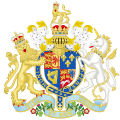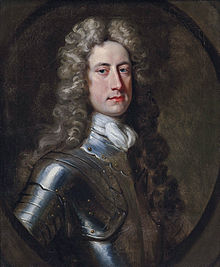Secretary of State for the Northern Department
| Great Britain Office of the Secretary of State for the Northern Department | |
|---|---|
 Coat of Arms of the Kingdom of Great Britain Government | |
| TheNorthern Department | |
| Style | The Right Honourable (Formal prefix) |
| Member of | British Cabinet |
| Seat | Westminster,London |
| Appointer | TheBritish Monarch on advice of thePrime Minister |
| Term length | No fixed term |
| Formation | 1660-1782 |
| First holder | Sir William Morice |
| Final holder | David Murray, 7th Viscount Stormont |
TheSecretary of State for the Northern Departmentwas a position in theCabinetof the government ofGreat Britainup to 1782. Then theNorthern Departmentbecame theForeign Officeand the position evolved into theForeign Secretary.[1][2]
History
[edit]Before theAct of Union, 1707,the Secretary of State's responsibilities were in relation to theEnglishgovernment, not theBritish.Even after the Union, there was still a separateSecretary of State for Scotlanduntil 1746, though the post was sometimes vacant. This continued the previous Scottish government post ofSecretary of State.
Before 1782, the responsibilities of the twoSecretaries of Statefor the Northern and the Southern Departments were not divided up in terms of area of authority, but rather geographically. The Secretary of State for the Northern Department was responsible for relations with theNetherlands,Scandinavia,Poland,Russia,and theHoly Roman Empire.The Secretary of State for the Southern Department was responsible forIreland,theChannel Islands,France,Spain,Portugal,Switzerland,theItalian states,and theOttoman Empire.He was also responsible for theAmerican coloniesuntil 1768, when the charge was given to theSecretary of State for the Colonies.Domestic responsibilities inEnglandandWaleswere shared between the two Secretaries. After the union withScotlandin 1707, the two secretaries also took responsibility forScotlandwhen there was noSecretary of State for Scotlandin office.[3]
Until 1706, the practice was generally for the senior official to lead the Southern Department, and the junior the Northern Department, with the Northern Secretary being transferred to the Southern Department when a vacancy arose at the latter.[3]During the reigns ofGeorge IandGeorge II,however, the Northern Department began to be seen as the more important, since its responsibilities included the monarchs' ancestral home ofHanover.[4]During the reign ofGeorge III,the two departments were of approximately equal importance.[5]
In 1782, the two Secretaries of State were reformed as theSecretary of State for the Home Departmentand theSecretary of State for Foreign Affairs.[6] During the 18th century, Secretaries of State for the Northern Department, ifpeers,were oftenLeaders of the House of Lordsas well.
Secretaries of State for the Northern Department, 1660–1782
[edit]Included:[7]
| Portrait | Name Constituency |
Term of office | Notes | |
|---|---|---|---|---|

|
SirWilliam Morice MP forPlymouth |
27 May 1660 |
29 September 1668 | |

|
SirJohn Trevor MP forArundeluntil 1661 MP forGreat Bedwynafter 1661 |
29 September 1668 |
8 July 1672 | |

|
Henry Coventry MP forDroitwich |
3 July 1672 |
11 September 1674 | |

|
SirJoseph Williamson MP forThetford |
11 September 1674 |
20 February 1679 | |

|
Robert Spencer The Earl of Sunderland |
10 February 1679 |
26 April 1680 | |

|
SirLeoline Jenkins MP forOxford University |
26 April 1680 |
2 February 1681 | |

|
Edward Conway The Earl of Conway |
2 February 1681 |
January 1683 | |

|
Robert Spencer The Earl of Sunderland |
28 January 1683 |
1684 | |

|
Sidney Godolphin MP forHelston |
17 April 1684 |
24 August 1684 | |

|
Charles Middleton The Earl of Middleton MP forWinchelseaafter 1685 |
24 August 1684 |
28 October 1688 | |

|
Richard Graham The Viscount Preston MP forCumberland |
29 October 1688 |
2 December 1688 | |

|
Daniel Finch The Earl of Nottingham |
5 March 1689 |
26 December 1690 | |

|
Henry Sydney The Viscount Sydney |
26 December 1690 |
3 March 1692 | |

|
SirJohn Trenchard MP forPoole |
23 March 1693 |
2 March 1694 | |

|
Charles Talbot The Duke of Shrewsbury |
2 March 1694 |
3 May 1695 | |

|
SirWilliam Trumbull MP forOxford University |
3 May 1695 |
2 December 1697 | |

|
James Vernon MP forPenrynuntil 1699 MP forWestminsterafter 1699 |
2 December 1697 |
5 November 1700 | |

|
SirCharles Hedges MP forMalmesbury |
5 November 1700 |
29 December 1701 | |

|
James Vernon MP forWestminster |
4 January 1702 |
1 May 1702 | |

|
SirCharles Hedges MP forMalmesburyuntil 1702 MP forCalneafter 1702 |
2 May 1702 |
18 May 1704 | |

|
Robert Harley MP forRadnor |
16 May 1704 |
13 February 1708 | |

|
Henry Boyle MP forWestminster |
13 February 1708 |
21 September 1710 | |

|
Henry St John The Viscount Bolingbroke MP forBerkshireuntil 1712 Viscount Bolingbrokeafter 1712 |
21 September 1710 |
17 August 1713 | |

|
SirWilliam Bromley MP forOxford University |
17 August 1713 |
17 September 1714 | |

|
Charles Townshend The Viscount Townshend |
17 September 1714 |
12 December 1716 | |

|
James Stanhope | 12 December 1716 |
12 April 1717 | |

|
Charles Spencer The Earl of Sunderland |
12 April 1717 |
2 March 1718 | |

|
James Stanhope The Earl Stanhope |
19 March 1718 |
4 February 1721 | |

|
John Carteret The Lord Carteret |
5 February 1721 |
21 February 1721 | |

|
Charles Townshend 2ndViscount Townshend |
21 February 1721 |
16 May 1730 | |

|
William Stanhope The Lord Harrington |
19 June 1730 |
12 February 1742 | |

|
John Carteret The Lord Carteret |
12 February 1742 |
24 November 1744 | |

|
William Stanhope The Earl of Harrington |
24 November 1744 |
January 1746 | |

|
John Carteret The Earl Granville |
12 February 1746 |
March 1746 |
as sole Secretary |

|
William Stanhope The Earl of Harrington |
March 1746 |
19 October 1746 | |

|
Philip Dormer Stanhope The Earl of Chesterfield |
29 October 1746 |
6 February 1748 | |

|
Thomas Pelham-Holles The Duke of Newcastle |
6 February 1748 |
23 March 1754 | |

|
Robert Darcy The Earl of Holdernesse |
April 1757 |
June 1757 |
as sole Secretary |

|
John Stuart The Earl of Bute |
25 March 1761 |
27 May 1762 | |

|
George Grenville MP forBuckingham |
5 June 1762 |
9 October 1762 | |

|
George Montagu-Dunk The Earl of Halifax |
14 October 1762 |
9 September 1763 | |

|
John Montagu The Earl of Sandwich |
9 September 1763 |
10 July 1765 | |

|
George Montagu-Dunk The Earl of Halifax |
September 1763 |
July 1765 | |

|
Augustus Henry Fitzroy The Duke of Grafton |
12 July 1765 |
14 May 1766 | |

|
Henry Seymour Conway MP forThetford |
23 May 1766 |
20 January 1768 | |

|
Thomas Thynne The Viscount Weymouth |
20 January 1768 |
21 October 1768 | |

|
William Nassau de Zuylestein The Earl of Rochford |
21 October 1768 |
19 December 1770 | |

|
John Montagu The Earl of Sandwich |
19 December 1770 |
12 January 1771 | |

|
George Montagu-Dunk The Earl of Halifax |
22 January 1771 |
6 June 1771 | |

|
Henry Howard The Earl of Suffolk |
12 June 1771 |
7 March 1779 | |

|
David Murray The Viscount Stormont |
27 October 1779 |
27 March 1782 | |
See also
[edit]References
[edit]- ^"The FCO: Policy, People and Places (1782-1995)".FCO Historians.History Notes (2). Foreign and Commonwealth Office: 1. April 1991.
- ^"The National Archives' catalogue: Records assembled by the State Paper Office, including papers of the Secretaries of State up to 1782".The National Archives.
- ^abThomson, Mark A. (1932).The Secretaries of State: 1681-1782.London: Frank Cass. pp. 2–3.
- ^Cass (1932), pp. 21-22
- ^Cass (1932), p. 4
- ^Sainty, J. C. (1973). "Introduction".Office-Holders in Modern Britain: Volume 2 - Officials of the Secretaries of State 1660-1782.University of London. pp. 1–21 – via British History Online.
At the Restoration [in 1660] the practice of appointing two Secretaries of State, which was well established before the Civil War, was resumed. Apart from the modifications which were made necessary by the occasional existence of a third secretaryship, the organisation of the secretariat underwent no fundamental change from that time until the reforms of 1782 which resulted in the emergence of the Home and Foreign departments.... English domestic affairs remained the responsibility of both Secretaries throughout the period. In the field of foreign affairs there was a division into a Northern and a Southern Department, each of which was the responsibility of one Secretary. The distinction between the two departments emerged only gradually. It was not until after 1689 that their names passed into general currency. Nevertheless the division of foreign business itself can, in its broad outlines, be detected in the early years of the reign of Charles II.
- ^Sainty, J. C."Lists of appointments British History Online".www.british-history.ac.uk.Originally published by University of London, London, 1973.Retrieved12 March2017.
Sources
[edit]- Anson, Sir William Reynell(1892).The Law and Custom of the Constitution.Clarendon Press. pp.157–158.Retrieved18 August2007.
- Sainty, J.C.(1973).Office-Holders in Modern Britain: Volume 2 Officials of the Secretaries of State 1660-1782.pp. 22–58.Retrieved19 August2007.
- Secretaries of state for the Northern Department
- Defunct ministerial offices in the United Kingdom
- Lists of English politicians
- Lists of government ministers of the United Kingdom
- Great Britain politics-related lists
- Secretaries of state of the Kingdom of England
- Kingdom of Great Britain
- Politics of Scotland
- 17th century in the British Empire
- 18th century in the British Empire
- 17th century in England
- Foreign relations of Great Britain
- Northern England
- 1660 establishments in England
- 1782 disestablishments in Great Britain
- 1660 establishments in the British Empire
- 1782 disestablishments in the British Empire

